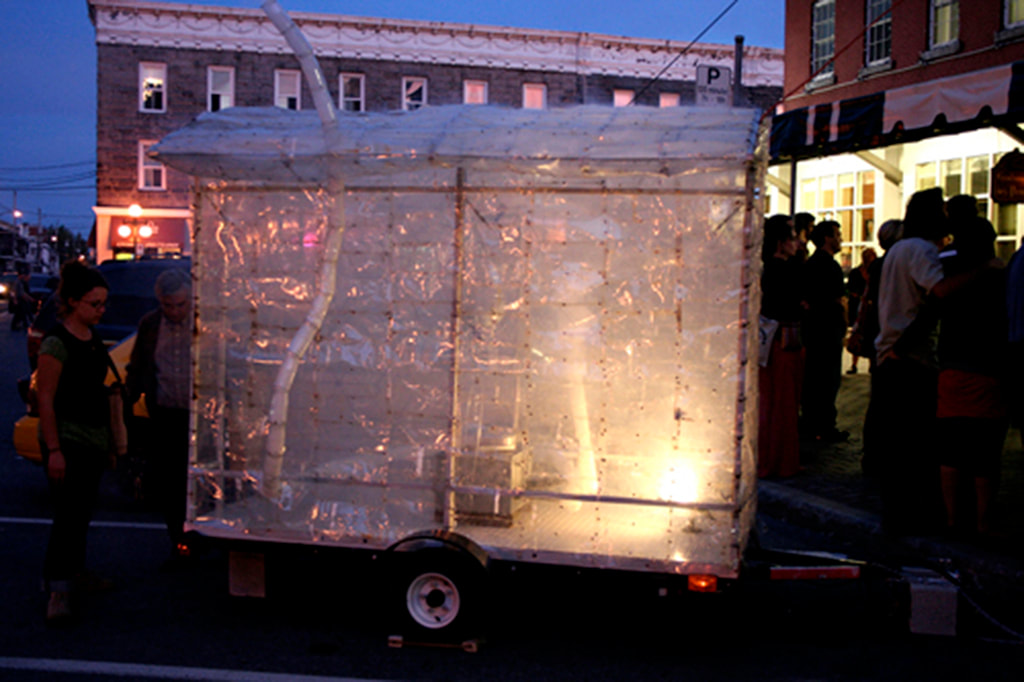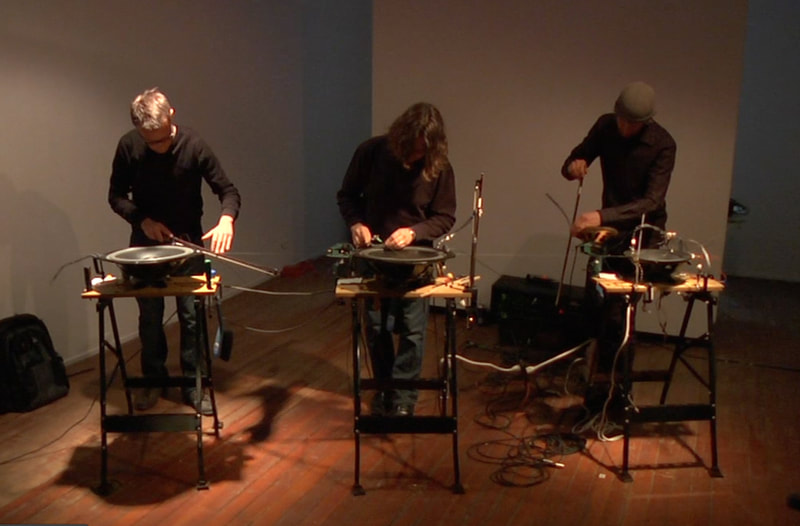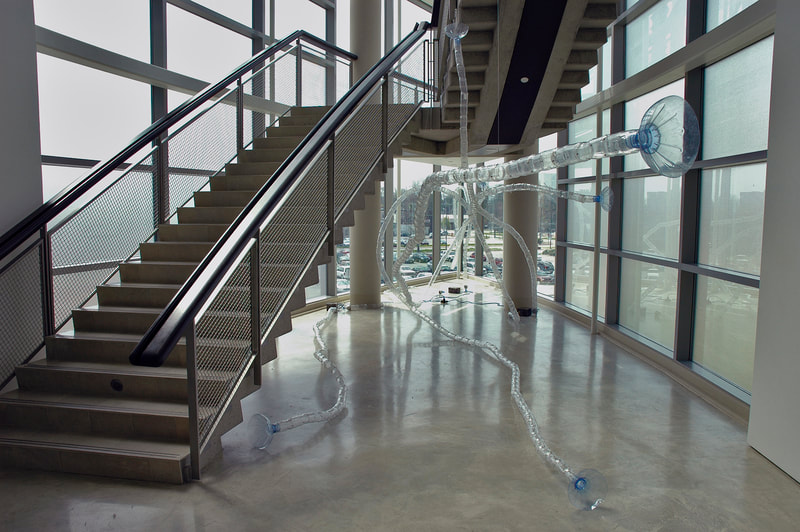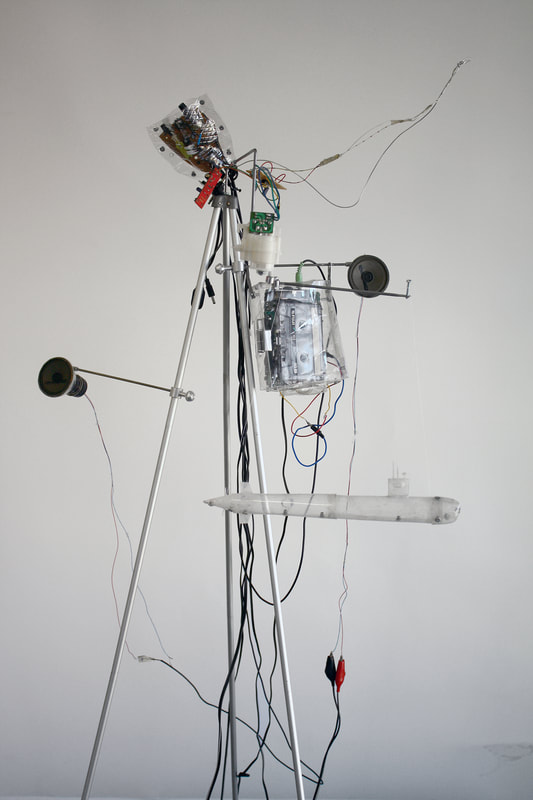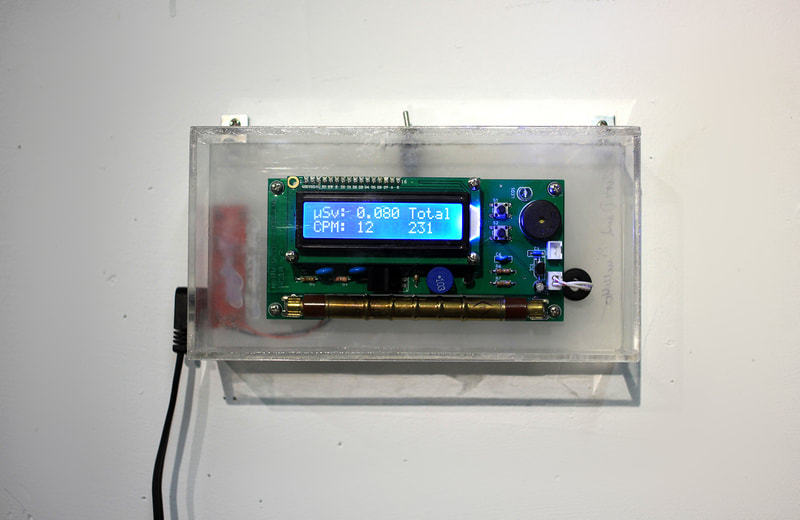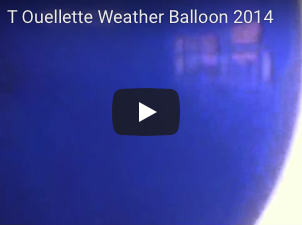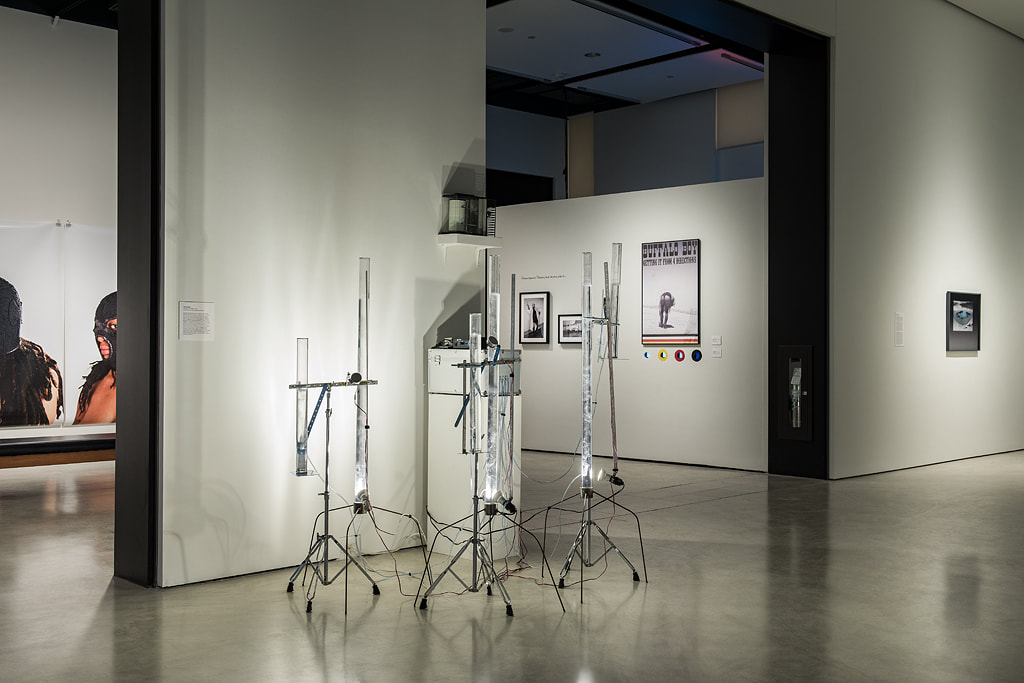2021-2022
Synæsthetics
Troy David Ouellette, PhD
Assistant Professor, Visual Art
Brock University | Marilyn I. Walker School of Fine and Performing Arts
"To remember an event is to experience it again, but not in the same way as the first time. Memory is a special kind of experience because it is composed of selected impressions, whereas actual experience is a welter of sights, sounds, feelings, physical strains, expectations, and minute, undeveloped reactions. Memory sifts all this material and represents it in the form of distinguishable events. Sometimes the events are logically connected, so that sheer remembering can date them with respect to each other; that is, in a vivid recollection of (say) coming down a hill, the sense of being high up and of treading dry gravel has merged into that of accelerated motion, of the horizon's lifting all around, of places near the bottom of the path; and the whole series of changes may be remembered. Any special adventure along the way then finds its temporal frame in the memory itself. But most events are recalled as separated incidents, and can be dated only by being thought of in a causal order in which they are not "possible" except at certain times. The other items in this causal order are one's various other memories, but the order itself is an intellectual system."[1]
Susanne K. Langer, Feeling and Form: A Theory of Art, 1953
Introduction
I begin with this quotation by the Philosopher Susanne Langer to reiterate the connection between sense and memory. In “Feeling and Form” she pioneered the field of Affect Theory insofar as sensations would guide the human spirit to act and react to various sensory inputs through emotions. Her emphasis on creation and practice is something that attracted me to her ideas and certainly made me think of poiesis – where thought is brought into being.
In what follows, I present a broad approach concerning questions surrounding Synæsthetics and its link to synesthesia, cognition and culture. This introduction highlights the differences (and some similarities) between terminology that is often exchangeable, like perception, sense, memory, awareness, sensation and consciousness. It argues for incorporating the senses into the canon of art historical discourse, as well as for evaluating the senses as agents of historical research. It's my goal to contribute concepts that consider sense technologies as they relate to everyday experience and show how they bridge gaps in our organic senses hopefully without any favour of technological utopianism. I will try not to overlook the political implications of technological controls over the freedoms in which societies worldwide still struggle. As Langer states “…the philosophy of art requires the standpoint of the artist to test the power of its concepts and prevent empty or naive generalizations.”[2]
Critiques within the field of media art offers a plethora of critical condemnations regarding the interplay of data, homogeneity, and privacy rights. Over the last half-century, the art and technology arena has had various names and meanings. Writers and practitioners have attempted to supply concrete examples of what would fall under the umbrella of electronic or media art. Art using electronic, technical and software-driven means has been named everything from intermedia, multimedia, transmedia, and interactive media to hypermedia, digital media and new media. These distinctions often relate to how the work is transmitted, received and produced through different technological means. Having "media" associated with the name suggests a connection with popular visual culture and current events. Bearing this in mind, I intend to cast a wide net, including various projects that reflect the vast diversity of what might be related explicitly to Synæsthetic art. Infinite possibilities to develop technologically-based skills within these mediums are not unlimited as these mediums developed; they are subject to specific investigations, collaborations, and human pursuits that drive things forward, splintering into varied objectives and interests. Rather than prioritizing digital constructs, I favour the notion that the digital and analogue worlds coexist as digital forms and systems are human constructs of binary codes and numbers. That is not to say that quantum processing power will not share a kinship with more organic and analogue decision-making processes.
The Link Between Synesthesia and Synæsthetics
Synesthesia as an experience within living organisms that is cross-modal. Its meaning expresses a union of the senses and is often developmental or acquired genetically or epigenetically and embodied within the individual. In contrast acquired synesthesia often arises from psychotropic drug ingestion or some neurological conditions not inherited. This condition may also operate on a sensory or conceptual level where a thought or sense consistently triggers a second perceptual experience, usually through a different sense. Another difference between acquired or developmental synaesthesia is that acquired synaesthesia does which does not demonstrate “either idiosyncrasy or automaticity or stability.”[3] Another distinction needs to be made for specific terminology related to ideas and sense. Put forward in a paper in 2009 on this topic Dr. Danko Nikolić devised a more specific term for thinking and ideas realized as sense called ideaesthesia where inducers evoke perception-like sensory experiences called concurrents.[4]
In this paper the Synæsthetics is a preferable term because it focus on aesthetics and attempts to account for the affective properties of materials rather than focusing on neurology and thought processes. By doing so it has the potential to consider interspecies sense as well as evolved organization as it relates to sense organisms and material environments. For the purposes of describing its relationship to media art I will sometimes cross the terminology to suit the psychological state and the electronic mechanisms and expressions of data to draw these relationships. For instance, a generator of experience may be referred to as an inducer. The conclusion that is being made here is that technologies takes on new sensory possibilities as the spectrum of sonic and visual possibilities is extended. An example would be infrared spectrum awareness through electronic sense and processing. These types of computational functions for processing sense data have possibilities directly feed into media art processes. Perhaps one of the powerful capacities that Media Art promotes is that it provides a counter to many technological pursuits that aim to use information in rather disturbing ways – either through militarism or data mining. These new forms of creative research may indeed shift academic and private developments to help city infrastructure, navigation, assist with environmental remediation among many other things. At least amongst the multitude of prevailing dystopian futures there may be a way for artists to insert themselves in a creative narrative that may counter more destructive outcomes. In the vast arena of human imagination one can at least hope that healthy doses of criticism and deconstruction will help to keep power and grand narratives in check.
Media Art, as it has been commonly known, has had multitudinous names over the years. Within its long history involving kinetic and electronic work it varied multidisciplinary pursuits have enabled almost infinite combinations of projects by the equally diverse ideas of its creative practitioners. It has been labeled as intermedia, multimedia, transmedia, interactive media and hypermedia to name a few. More often than not, these distinctions relate to how it is transmitted, received and produced through different technological and material means. For the purpose of preparing this text I will be casting a wide net including various projects that reflect the vast diversity of what might fall under the umbrella of Synæsthetic art. Philosophically it goes without saying that infinite possibilities to develop technologically-based art within these mediums is not infinite. As these mediums developed, they were subject to specific investigations, collaborations, and mostly human pursuits that drive things forward splintering into varied sub-genres. To keep everything on point I intend to focus on the research of Canadian Media Art practitioners whose work might integrate with the fundamental ideas of Synæsthetics.
In preparing this book, the link between synesthesia, as a physical and sensory expression, and the use of technology in media arts became readily apparent. This articulation begged a critical research question. Were media artists interested in investigating jumping from one sense to another using sensory technologies? If so, what were some of the art historical examples? Finally, why have these inherent bridges between hardware and software sensory technologies been so predominant since the inception of media art practice? Is it because technologies are sense-driven? Before delving into this, it is essential to explain some of the concepts. First, Synæsthetics is a neologism for any technology, especially technological artworks, that use sensory data collection to affect future outcomes in various forms. By morphing into something else based on data or a phenomenon, past or present synæsthetic works create awareness within lived experience.[5] The future possibility or probability of cause and effect relationships may also play a part in the way visuals, audio, or any other sense factor unfolds. The predictions of outcomes become part of the work by using algorithms, projections, statistics, or differential inputs that drive the complexity of the data to a live output. Formed between any living sensing organism, affective, emotional and intuitive relationships become entwined and embodied in the organism as systems of behaviour. It might be useful here to draw an association between tangible benefits of Synæsthetic art and an internet of things that have responsive capabilities that could act as somatic bridges to other living organisms as it will be discussed in-depth in this text.
As a Media Artist/Researcher, it was apparent that sensors and electronics drive projects through detection and the processing of signals. The diphthong used in the title "Synæsthetics" conjoined "a" and "e" as a way to signify how arts and electronics share an affinity. It also alludes to the difference in the two spellings of esthetics and aesthetics used differently by authors explaining various theoretical constructs and resonates with Systems Esthetics, which came to the fore as early as the 1960s. Promoted by Jack Burnham, Systems Esthetics is still very relevant insofar as software has had a dominant influence in our daily lives. Burnham, in this way, was prophetic when it came to the insights about how creativity and software would become entwined with the complexities of everyday life. An example of this I did a quick search for the word “chrome” thinking I would find the material and was multiple listings deep in software browser application links before coming across what I wanted. Not only was I looking on a computer to get at the information, but I realized that the language I used was being replaced by more pervasive systems taking on words usually signifying something completely different.
Our current impetus to analyze and identify phenomena, movement, and material through electronic mediation brings us new horizons - at least in the sense that we move and negotiate what we think is spatial, physical or temporal reality. This mediation seems more predominant now than ever when the aesthetic use of electronics (at least in the early to mid-20th century B.C.E.) focused on electro/mechanical projects that included kinetic sculpture or communicated works through telephone lines. In works like Atsuko Tanaka's "Electric Dress," electricity was foregrounded and pushed multiple boundaries in fashion/anti-fashion with its unique and innovative way of discussing the body juxtaposed with an electrified world. When electronics became much more accessible to artists, fundamental paradigm shifts in media arts were revolutionary. At the same time (during the 1960s-1970s), there was also an explosion in studies of cognition, neuroscience, perception, psychoanalytic and gestalt psychology and information processing, to name a few. Concurrently, artists, sociologists, cultural theorists and linguists were studying the affects and effects of new developments in electronic communications. It took collaborations between industry and arts to create significant changes, as seen in events like Experiments in Technology's "9 Evenings" and other projects by its members that started to bring sense technologies to the fore. In this case, these dynamic 1966 performances bridged so many disciplines and ideas that their relevance will continue long into the future ushering a continuance of creative pursuits only possible with the development of evermore instruments used to measure and record phenomena.
It is essential to focus on the various trajectories that have had a bearing on the development of media art as it exists today. There are many trajectories at play with at least three lines of inquiry. The first iteration came out of the study of perception and memory associated with sense and grew out of the field of visual and sonic arts. One could use Cymatics as an example where particles (like sand) on the surface of a plate indicate regions of displacement. These patterns are affected by variables as wide-ranging as plate thickness, sound frequencies or the materials that comprise the particles. This is different from sonification, where data translates into sound, but it illustrates where Synæsthetics is perhaps more clearly linked. The proponents of these form-finding fields within the early part of 20th-century experimental practice became interested in the psycho-sensory mechanisms of the brain, which spoke to colour theory, materials and perception, reception and transmission dovetailing with Psychology and Psychoanalysis. These early forms of Bauhaus-inspired Eurocentric 20th-century scholarship were most evident in the Op Art and Abstraction analysis. There were also kinships with morphology as pattern thinking was created to understand a commonality of characteristics that would bridge various cultural and aesthetic forms and as a way to traverse stylistic variations. Concurrently these more formal concerns also became a large part of the pedagogy within institutions until the linguistic turn was introduced (mainly in the late 1960s) within Western pedagogy, ushering in more anthropocentric approaches at a time when environmental art was also being born. It is important to note that linguistics and computer programming share similarities as systems and the natural leap from learning lines of code and language cannot be understated. More importantly, although perpetuating a binary between objectivity and subjectivity, this formal analysis (usually involving the elements and principles of design) helped lay foundations that traversed notions regarding creativity, emotion, intuition, and interpretation. Concurrently the notion of how materials (and their interactions) became interactive, kinetic, and complex as the temporal experience was also identified through the sculptural works of Jean Tinguely and the more absurdist projects with direct lineage in Symbolism, Dada and Surrealism as Western Eurocentric constructs. Often borrowing from dreams and appropriating from various cultures and traditions, these works of flight and fancy became a way to disrupt the concrete narratives we see in logic and scientific progress. Imagine the historical implications of the recorded totality of what is possible in any given time - to the discipline of history! An example of such a thing lies with google street view when we come to understand the lineage of families residing in a genealogical context. This is also often missed in terms of the acoustic contexts. Imagine representations of streets in google maps!!! In this way the other senses are completely left out of the record.
In the second instance, the fields of Neuroscience also played a role. By the 1960s, as computer science became quite sophisticated, there was a desire to link human thought and machine sense. As a result, cybernetics and more advanced A.I. became conjoined within the purview of artificially sensing the world. During the 1960s, systems art and decision-making processes emerged within conceptual art - now deemed art-techno-science collaborations. This meeting of minds happened through investigations by many independent artists and academics. However, it gained much more momentum through institutional organizations such as C.A.V.S. (Center for Advanced Visual Studies) at M.I.T. and more independent collaborations like E.A.T. (Experiments in Art and Technology) that collaborated with corporations and governments at all levels to secure these partnerships. One can emphasize this connection by examining two significant exhibitions, "Cybernetic Serendipity" and "Software," which featured elements that embraced the notion that biological intelligence could be augmented or integrated with computer processes linked to databases. The trajectories of these vast fields influenced O.C.R., A.I. and voice recognition, as well as cybersecurity insofar as predictive algorithms interact with human decision-making processes. This connection will be more widely discussed in chapter two as it relates to power, militarism and economic concerns.
The third iteration of how Synæsthetic media art grew as a field of inquiry stems from the world of fantasy, utopian projects and notions of social and political engagement within the discipline of architecture and the built environment. These proposed (often unbuilt) structures involved transportation systems and adaptable social space considerations with interconnectivity as part of the design. Tatlin's monument to the Third International is likely one of the most interesting proposed structures of Russian art. Simultaneously, we can also see the buildup of the organizational complex, computer-controlled transport, and sensory-controlled buildings (known more widely today as "smart" buildings). How synaesthetics is linked to networks, systems and grids and information processing is evident here - not to mention industrial time management considerations, which grew out of Taylorism to increase signals sent to and from machines based on operations and material interactions. The connection here lies with efficiency and communication systems that allow instructions to be sent and received as quickly as possible or in real-time. The plan to electrify the world and bring energy supply to cities underscored the motivation of governments and corporations to create a socially integrated world that is interconnected and somewhat dependent on these supplies.
In chapter 5, on Intersectional Synæsthetics the nuance of identity and intersectionality is perhaps more recent insofar as it pertains to more specific cultural, racial, political and gendered situations and environments and how they mingle and coexist in complex ways. Growing out of social history, creative ethics and appropriation, political struggle and social justice issues it functions within the discursive spaces of real protests and legal battles as well as through the controlled discursive spaces of social media and public places of display and contemplation.
[1] Langer, Susanne, Feeling and Form: A Theory of Art (New York: Charles Scribner's Sons, 1953) P 263
[2] Langer, Susanne, Feeling and Form: A Theory of Art (New York: Charles Scribner’s Sons, 1953)
[3] Safran, A. B., & Sanda, N. (2015, February). Color synesthesia. insight into perception, emotion, and consciousness. Current opinion in neurology. Retrieved July 5, 2022, from https://www.ncbi.nlm.nih.gov/pmc/articles/PMC4286234/
[4] Nikolić, D. (2009) Is synaesthesia actually ideaesthesia? An inquiry into the nature of the phenomenon. Proceedings of the Third International Congress on Synaesthesia, Science & Art, Granada, Spain, April 26–29, 2009.
[5] Synaesthetics may also share some ideas with Synectics, which was developed in 1950s America that looked at creative problem-solving methods where the subject(s) may be unaware of the processes involved. The main difference is that rather than a process that specifically targets a psychology of creativity Synaesthetics is a way for various transformative ques that are data-driven and can be output in many sense forms (visual, sonic, haptic among others).
Synæsthetics
Troy David Ouellette, PhD
Assistant Professor, Visual Art
Brock University | Marilyn I. Walker School of Fine and Performing Arts
"To remember an event is to experience it again, but not in the same way as the first time. Memory is a special kind of experience because it is composed of selected impressions, whereas actual experience is a welter of sights, sounds, feelings, physical strains, expectations, and minute, undeveloped reactions. Memory sifts all this material and represents it in the form of distinguishable events. Sometimes the events are logically connected, so that sheer remembering can date them with respect to each other; that is, in a vivid recollection of (say) coming down a hill, the sense of being high up and of treading dry gravel has merged into that of accelerated motion, of the horizon's lifting all around, of places near the bottom of the path; and the whole series of changes may be remembered. Any special adventure along the way then finds its temporal frame in the memory itself. But most events are recalled as separated incidents, and can be dated only by being thought of in a causal order in which they are not "possible" except at certain times. The other items in this causal order are one's various other memories, but the order itself is an intellectual system."[1]
Susanne K. Langer, Feeling and Form: A Theory of Art, 1953
Introduction
I begin with this quotation by the Philosopher Susanne Langer to reiterate the connection between sense and memory. In “Feeling and Form” she pioneered the field of Affect Theory insofar as sensations would guide the human spirit to act and react to various sensory inputs through emotions. Her emphasis on creation and practice is something that attracted me to her ideas and certainly made me think of poiesis – where thought is brought into being.
In what follows, I present a broad approach concerning questions surrounding Synæsthetics and its link to synesthesia, cognition and culture. This introduction highlights the differences (and some similarities) between terminology that is often exchangeable, like perception, sense, memory, awareness, sensation and consciousness. It argues for incorporating the senses into the canon of art historical discourse, as well as for evaluating the senses as agents of historical research. It's my goal to contribute concepts that consider sense technologies as they relate to everyday experience and show how they bridge gaps in our organic senses hopefully without any favour of technological utopianism. I will try not to overlook the political implications of technological controls over the freedoms in which societies worldwide still struggle. As Langer states “…the philosophy of art requires the standpoint of the artist to test the power of its concepts and prevent empty or naive generalizations.”[2]
Critiques within the field of media art offers a plethora of critical condemnations regarding the interplay of data, homogeneity, and privacy rights. Over the last half-century, the art and technology arena has had various names and meanings. Writers and practitioners have attempted to supply concrete examples of what would fall under the umbrella of electronic or media art. Art using electronic, technical and software-driven means has been named everything from intermedia, multimedia, transmedia, and interactive media to hypermedia, digital media and new media. These distinctions often relate to how the work is transmitted, received and produced through different technological means. Having "media" associated with the name suggests a connection with popular visual culture and current events. Bearing this in mind, I intend to cast a wide net, including various projects that reflect the vast diversity of what might be related explicitly to Synæsthetic art. Infinite possibilities to develop technologically-based skills within these mediums are not unlimited as these mediums developed; they are subject to specific investigations, collaborations, and human pursuits that drive things forward, splintering into varied objectives and interests. Rather than prioritizing digital constructs, I favour the notion that the digital and analogue worlds coexist as digital forms and systems are human constructs of binary codes and numbers. That is not to say that quantum processing power will not share a kinship with more organic and analogue decision-making processes.
The Link Between Synesthesia and Synæsthetics
Synesthesia as an experience within living organisms that is cross-modal. Its meaning expresses a union of the senses and is often developmental or acquired genetically or epigenetically and embodied within the individual. In contrast acquired synesthesia often arises from psychotropic drug ingestion or some neurological conditions not inherited. This condition may also operate on a sensory or conceptual level where a thought or sense consistently triggers a second perceptual experience, usually through a different sense. Another difference between acquired or developmental synaesthesia is that acquired synaesthesia does which does not demonstrate “either idiosyncrasy or automaticity or stability.”[3] Another distinction needs to be made for specific terminology related to ideas and sense. Put forward in a paper in 2009 on this topic Dr. Danko Nikolić devised a more specific term for thinking and ideas realized as sense called ideaesthesia where inducers evoke perception-like sensory experiences called concurrents.[4]
In this paper the Synæsthetics is a preferable term because it focus on aesthetics and attempts to account for the affective properties of materials rather than focusing on neurology and thought processes. By doing so it has the potential to consider interspecies sense as well as evolved organization as it relates to sense organisms and material environments. For the purposes of describing its relationship to media art I will sometimes cross the terminology to suit the psychological state and the electronic mechanisms and expressions of data to draw these relationships. For instance, a generator of experience may be referred to as an inducer. The conclusion that is being made here is that technologies takes on new sensory possibilities as the spectrum of sonic and visual possibilities is extended. An example would be infrared spectrum awareness through electronic sense and processing. These types of computational functions for processing sense data have possibilities directly feed into media art processes. Perhaps one of the powerful capacities that Media Art promotes is that it provides a counter to many technological pursuits that aim to use information in rather disturbing ways – either through militarism or data mining. These new forms of creative research may indeed shift academic and private developments to help city infrastructure, navigation, assist with environmental remediation among many other things. At least amongst the multitude of prevailing dystopian futures there may be a way for artists to insert themselves in a creative narrative that may counter more destructive outcomes. In the vast arena of human imagination one can at least hope that healthy doses of criticism and deconstruction will help to keep power and grand narratives in check.
Media Art, as it has been commonly known, has had multitudinous names over the years. Within its long history involving kinetic and electronic work it varied multidisciplinary pursuits have enabled almost infinite combinations of projects by the equally diverse ideas of its creative practitioners. It has been labeled as intermedia, multimedia, transmedia, interactive media and hypermedia to name a few. More often than not, these distinctions relate to how it is transmitted, received and produced through different technological and material means. For the purpose of preparing this text I will be casting a wide net including various projects that reflect the vast diversity of what might fall under the umbrella of Synæsthetic art. Philosophically it goes without saying that infinite possibilities to develop technologically-based art within these mediums is not infinite. As these mediums developed, they were subject to specific investigations, collaborations, and mostly human pursuits that drive things forward splintering into varied sub-genres. To keep everything on point I intend to focus on the research of Canadian Media Art practitioners whose work might integrate with the fundamental ideas of Synæsthetics.
In preparing this book, the link between synesthesia, as a physical and sensory expression, and the use of technology in media arts became readily apparent. This articulation begged a critical research question. Were media artists interested in investigating jumping from one sense to another using sensory technologies? If so, what were some of the art historical examples? Finally, why have these inherent bridges between hardware and software sensory technologies been so predominant since the inception of media art practice? Is it because technologies are sense-driven? Before delving into this, it is essential to explain some of the concepts. First, Synæsthetics is a neologism for any technology, especially technological artworks, that use sensory data collection to affect future outcomes in various forms. By morphing into something else based on data or a phenomenon, past or present synæsthetic works create awareness within lived experience.[5] The future possibility or probability of cause and effect relationships may also play a part in the way visuals, audio, or any other sense factor unfolds. The predictions of outcomes become part of the work by using algorithms, projections, statistics, or differential inputs that drive the complexity of the data to a live output. Formed between any living sensing organism, affective, emotional and intuitive relationships become entwined and embodied in the organism as systems of behaviour. It might be useful here to draw an association between tangible benefits of Synæsthetic art and an internet of things that have responsive capabilities that could act as somatic bridges to other living organisms as it will be discussed in-depth in this text.
As a Media Artist/Researcher, it was apparent that sensors and electronics drive projects through detection and the processing of signals. The diphthong used in the title "Synæsthetics" conjoined "a" and "e" as a way to signify how arts and electronics share an affinity. It also alludes to the difference in the two spellings of esthetics and aesthetics used differently by authors explaining various theoretical constructs and resonates with Systems Esthetics, which came to the fore as early as the 1960s. Promoted by Jack Burnham, Systems Esthetics is still very relevant insofar as software has had a dominant influence in our daily lives. Burnham, in this way, was prophetic when it came to the insights about how creativity and software would become entwined with the complexities of everyday life. An example of this I did a quick search for the word “chrome” thinking I would find the material and was multiple listings deep in software browser application links before coming across what I wanted. Not only was I looking on a computer to get at the information, but I realized that the language I used was being replaced by more pervasive systems taking on words usually signifying something completely different.
Our current impetus to analyze and identify phenomena, movement, and material through electronic mediation brings us new horizons - at least in the sense that we move and negotiate what we think is spatial, physical or temporal reality. This mediation seems more predominant now than ever when the aesthetic use of electronics (at least in the early to mid-20th century B.C.E.) focused on electro/mechanical projects that included kinetic sculpture or communicated works through telephone lines. In works like Atsuko Tanaka's "Electric Dress," electricity was foregrounded and pushed multiple boundaries in fashion/anti-fashion with its unique and innovative way of discussing the body juxtaposed with an electrified world. When electronics became much more accessible to artists, fundamental paradigm shifts in media arts were revolutionary. At the same time (during the 1960s-1970s), there was also an explosion in studies of cognition, neuroscience, perception, psychoanalytic and gestalt psychology and information processing, to name a few. Concurrently, artists, sociologists, cultural theorists and linguists were studying the affects and effects of new developments in electronic communications. It took collaborations between industry and arts to create significant changes, as seen in events like Experiments in Technology's "9 Evenings" and other projects by its members that started to bring sense technologies to the fore. In this case, these dynamic 1966 performances bridged so many disciplines and ideas that their relevance will continue long into the future ushering a continuance of creative pursuits only possible with the development of evermore instruments used to measure and record phenomena.
It is essential to focus on the various trajectories that have had a bearing on the development of media art as it exists today. There are many trajectories at play with at least three lines of inquiry. The first iteration came out of the study of perception and memory associated with sense and grew out of the field of visual and sonic arts. One could use Cymatics as an example where particles (like sand) on the surface of a plate indicate regions of displacement. These patterns are affected by variables as wide-ranging as plate thickness, sound frequencies or the materials that comprise the particles. This is different from sonification, where data translates into sound, but it illustrates where Synæsthetics is perhaps more clearly linked. The proponents of these form-finding fields within the early part of 20th-century experimental practice became interested in the psycho-sensory mechanisms of the brain, which spoke to colour theory, materials and perception, reception and transmission dovetailing with Psychology and Psychoanalysis. These early forms of Bauhaus-inspired Eurocentric 20th-century scholarship were most evident in the Op Art and Abstraction analysis. There were also kinships with morphology as pattern thinking was created to understand a commonality of characteristics that would bridge various cultural and aesthetic forms and as a way to traverse stylistic variations. Concurrently these more formal concerns also became a large part of the pedagogy within institutions until the linguistic turn was introduced (mainly in the late 1960s) within Western pedagogy, ushering in more anthropocentric approaches at a time when environmental art was also being born. It is important to note that linguistics and computer programming share similarities as systems and the natural leap from learning lines of code and language cannot be understated. More importantly, although perpetuating a binary between objectivity and subjectivity, this formal analysis (usually involving the elements and principles of design) helped lay foundations that traversed notions regarding creativity, emotion, intuition, and interpretation. Concurrently the notion of how materials (and their interactions) became interactive, kinetic, and complex as the temporal experience was also identified through the sculptural works of Jean Tinguely and the more absurdist projects with direct lineage in Symbolism, Dada and Surrealism as Western Eurocentric constructs. Often borrowing from dreams and appropriating from various cultures and traditions, these works of flight and fancy became a way to disrupt the concrete narratives we see in logic and scientific progress. Imagine the historical implications of the recorded totality of what is possible in any given time - to the discipline of history! An example of such a thing lies with google street view when we come to understand the lineage of families residing in a genealogical context. This is also often missed in terms of the acoustic contexts. Imagine representations of streets in google maps!!! In this way the other senses are completely left out of the record.
In the second instance, the fields of Neuroscience also played a role. By the 1960s, as computer science became quite sophisticated, there was a desire to link human thought and machine sense. As a result, cybernetics and more advanced A.I. became conjoined within the purview of artificially sensing the world. During the 1960s, systems art and decision-making processes emerged within conceptual art - now deemed art-techno-science collaborations. This meeting of minds happened through investigations by many independent artists and academics. However, it gained much more momentum through institutional organizations such as C.A.V.S. (Center for Advanced Visual Studies) at M.I.T. and more independent collaborations like E.A.T. (Experiments in Art and Technology) that collaborated with corporations and governments at all levels to secure these partnerships. One can emphasize this connection by examining two significant exhibitions, "Cybernetic Serendipity" and "Software," which featured elements that embraced the notion that biological intelligence could be augmented or integrated with computer processes linked to databases. The trajectories of these vast fields influenced O.C.R., A.I. and voice recognition, as well as cybersecurity insofar as predictive algorithms interact with human decision-making processes. This connection will be more widely discussed in chapter two as it relates to power, militarism and economic concerns.
The third iteration of how Synæsthetic media art grew as a field of inquiry stems from the world of fantasy, utopian projects and notions of social and political engagement within the discipline of architecture and the built environment. These proposed (often unbuilt) structures involved transportation systems and adaptable social space considerations with interconnectivity as part of the design. Tatlin's monument to the Third International is likely one of the most interesting proposed structures of Russian art. Simultaneously, we can also see the buildup of the organizational complex, computer-controlled transport, and sensory-controlled buildings (known more widely today as "smart" buildings). How synaesthetics is linked to networks, systems and grids and information processing is evident here - not to mention industrial time management considerations, which grew out of Taylorism to increase signals sent to and from machines based on operations and material interactions. The connection here lies with efficiency and communication systems that allow instructions to be sent and received as quickly as possible or in real-time. The plan to electrify the world and bring energy supply to cities underscored the motivation of governments and corporations to create a socially integrated world that is interconnected and somewhat dependent on these supplies.
In chapter 5, on Intersectional Synæsthetics the nuance of identity and intersectionality is perhaps more recent insofar as it pertains to more specific cultural, racial, political and gendered situations and environments and how they mingle and coexist in complex ways. Growing out of social history, creative ethics and appropriation, political struggle and social justice issues it functions within the discursive spaces of real protests and legal battles as well as through the controlled discursive spaces of social media and public places of display and contemplation.
[1] Langer, Susanne, Feeling and Form: A Theory of Art (New York: Charles Scribner's Sons, 1953) P 263
[2] Langer, Susanne, Feeling and Form: A Theory of Art (New York: Charles Scribner’s Sons, 1953)
[3] Safran, A. B., & Sanda, N. (2015, February). Color synesthesia. insight into perception, emotion, and consciousness. Current opinion in neurology. Retrieved July 5, 2022, from https://www.ncbi.nlm.nih.gov/pmc/articles/PMC4286234/
[4] Nikolić, D. (2009) Is synaesthesia actually ideaesthesia? An inquiry into the nature of the phenomenon. Proceedings of the Third International Congress on Synaesthesia, Science & Art, Granada, Spain, April 26–29, 2009.
[5] Synaesthetics may also share some ideas with Synectics, which was developed in 1950s America that looked at creative problem-solving methods where the subject(s) may be unaware of the processes involved. The main difference is that rather than a process that specifically targets a psychology of creativity Synaesthetics is a way for various transformative ques that are data-driven and can be output in many sense forms (visual, sonic, haptic among others).

